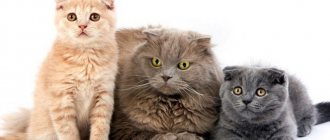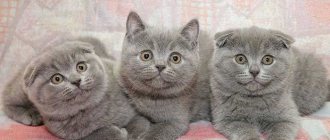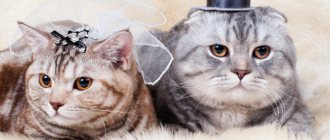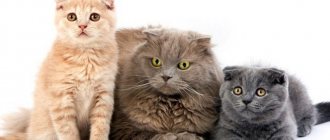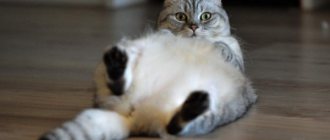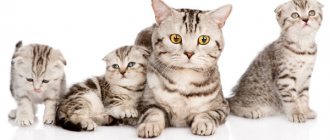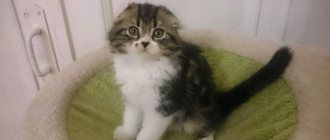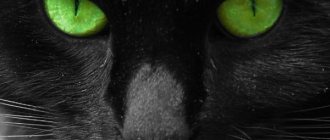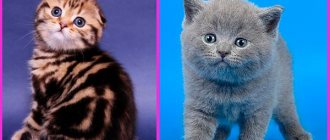Plain (solid)
This type of color implies a single rich shade of fur without ticking or patterns. Clear spots and hairs of a different shade are not allowed, which is quite difficult to achieve with a cream or red color. Such cats may have, but are undesirable, weak patterns on the tail, muzzle, paws, and less often on the body.
Solid colors are found in intense (black, red, chocolate) and diluted (marble, lilac, cream).
Scottish Fold - black (ebony) color
The color is mostly bright. Red, brown areas of the coat indicate a defect. Representatives of this color, considered mystical in ancient times, are not so rare among folds.
Scottish Fold - chocolate color
This beautiful coloring is not characterized by an undercoat of any other color, light hairs, or various patterns.
White
Snow-white with shine, no yellowness. In newborn babies, spots on the head are allowed to be bluish if there were blue ancestors in the family, or dark spots if one of the ancestors was black. In an adult, the fur becomes perfectly white.
Cinnamon
A rare warm color that looks no less impressive than rich chocolate.
Scottish Fold - color lilac (lavender)
Coffee with milk is how this exquisite, delicate shade of wool is characterized.
INTERESTING TO KNOW: Refined Abyssinian cat
Fawn
Kittens whose fur is colored in a touching soft beige shade (lightened cinnamon) look touching and cute.
Red
A rare color, implying the presence of an intense solid shade, evenly pigmented and distributed throughout the body. On the forehead and limbs, a faint pattern is acceptable, but undesirable. A light (red) tip of the tail is a breed defect.
Blue color (blue)
A classic color that allows for the entire blue color palette: both light and dark tones. The baby may have moire patterns, which will then disappear.
Cream
Diluted red with the addition of a delicate peach tone. A vague pattern on the forehead and legs is acceptable, but noticeable leopard markings are unacceptable.
Scottish cat color chart
Cats of the Scottish breed (Scottish Fold, Highland Fold, Scottish Straight and Highland Straight) are subject to the international color classification. It has symbols - numbers and letters. The code consists of:
1. Capital letters denoting the breed.
2. Lowercase letters indicating the primary color (blue, chocolate, etc.).
3. Pairs of numbers indicating the type of color (shaded, harlequin, Siamese, etc.) are numbers from 1 to 35.
4. Tail length - numbers from 51 to 54.
5. Eye color - numbers from 61 to 67.
6. Another additional pair of numbers can indicate the shape of the ears - 71 (straight ears of the Scottish Straight) and 73 (dropping and forward-curved ears of the Scottish Fold).
XXX.xx.NN.NN.NN.(NN)
xx - lowercase letter color designations:
| Designation | Colors |
| A | blue |
| b | chocolate, brown, chestnut (chocolate, brown, Havana, champagne) |
| With | lilac, lavender (lilac, lavender, platinum) |
| d | red, flame (red) |
| e | cream (cream) |
| f | tortoiseshell, patch (tortoiseshell) |
| g | blue-cream, blue-tortie (blue cream, blue tortoiseshell) |
| h | chocolate-tortie (chocolate tortoiseshell) |
| j | lilac-tortie (lilac tortoiseshell) |
| n | black, ebony, seal, sable, ruddy (black, ebony, seal, sable, wild) |
| o | sorrel, cinnamon, honey (sorrel, cinnamon, honey) |
| p | beige fawn (yellow-brown, beige) |
| q | sorrel tortie (red-brown tortoiseshell) |
| r | beige fawn tortie (beige tortoiseshell) |
| s | silver, smoke (silver, smoky) |
| w | white (white) |
| x | unregistered (unregistered color) |
| y | golden (golden) |
NN.NN.NN.(NN) - values of pairs of digits (up to three main and one auxiliary), starting with 0:
| Designation | Decoding |
| 01 | van (van) |
| 02 | harlequin (harlequin) |
| 03 | bicolour (two-color, bicolor) |
| 04 | mitted/white point (with white markings for color points) |
| 09 | little white spots (white spotting 1-2 cm) |
starting with 1:
| Designation | Decoding |
| 11 | shaded (shaded, i.e. 1/4 of the top part of the hair is darkened) |
| 12 | tipped, shell (veiled, i.e. 1/8 of the top part of the hair is darkened) |
starting with 2:
| Designation | Decoding |
| 21 | tabby, agouti (striation, agouti factor) |
| 22 | blotched, marble |
| 23 | mackerel, tiger (mackerel, tiger) |
| 24 | spotted (spotted) |
| 25 | ticked (ticked or Abyssinian) |
starting with 3:
| Designation | Decoding |
| 31 | burmese (Burmese) |
| 32 | tonkinese (Tonkinese) |
| 33 | himalayan or siam (Himalayan, Siamese, point) |
| 34 | singapura (Singaporean) |
| 35 | abyssinian (Abyssinian) |
starting with 6 (eye color):
| Designation | Decoding |
| 61 | blue |
| 62 | yellow, golden (yellow, orange, golden) |
| 63 | oddeyed |
| 64 | green |
| 65 | burmese (eye color of Burmese cats) |
| 66 | tonkinese (eye color of Tonkinese cats) |
| 67 | himalayan or siam (eye color of Himalayan and Siamese cats) |
For example, a fold-eared cat of color ps 24 is a cat of silver spotted fawn color. Thus, as you can see, the color code is formed from letters and numbers, but there are a lot of variations in the colors of Scottish breed cats, because... various factors combine to form countless variations. Within the scope of this article it is impossible to show absolutely all the colors of Scottish cats, cats and kittens.
Bicolors
The color of a fur coat, in which a significant area of the coat is snow-white. The belly, chest, neck, chin, limbs, and muzzle must be white. Other shades are distributed evenly, without predominance in any area. The muzzle, like a royal sign, is decorated with a spot in the form of an inverted Latin “V”.
If there is an open white “collar” on the neck, the value of the animal increases.
The combination of snow-white is allowed with any of the available colors.
Color-pont
This type of color is considered rare among Scottish Fold cats. Folds owe their elite coloring to their British ancestors, who had Persians with a similar color in their family. The cat's body is light, and all protruding parts (ears, muzzle, tail, paws) are painted in brighter colors, forming an effective contrast with the main color shade.
Care
Scots are low maintenance. Keeping them in order does not require much time or special skills.
Wool
Short-haired cats need to be brushed once a week. Long-haired dogs deserve a little more attention. Highland Folds tend to form tangles and swallow hair, so it is worth brushing them at least three times a week. Ideally - every day. To make the procedure easier, you can purchase a furminator.
Fold cats need to be bathed with special shampoos once every two months, long-haired cats - monthly. You should also purchase a paste to remove hair from the body.
Nutrition
As for nutrition, here, like with any other cats, there are three options:
Natural food. They use various types of lean meat (chicken, veal, rabbit) raw or boiled, fermented milk products, eggs and fish. Raw meat is taken only after preliminary freezing for a week, chopped and heated slightly warmer than room temperature.
Ready-made dry food and spiders
The main thing here is to pay attention to the composition. The lower the cost, the lower the percentage of meat content and the higher the percentage of cereals, starch and flour.
It is better to take premium food.
Combined nutrition. This option is two meals a day. In the morning, they give ready-made food, and in the evening, self-prepared food, or vice versa. But experienced breeders do not recommend sticking to this option due to the risk of developing problems with the digestive tract.
The cat is fed from a clean bowl. Free access to clean drinking water must also be ensured. It needs to be changed at least once a day.
Caring for ears, eyes and more
In addition to fur, other parts of the body also require care:
- Eyes are examined daily. If necessary, wipe with a damp swab.
- The ears are cleaned approximately once every two weeks using a swab dipped in water. Using cotton swabs risks damaging your ear.
- Teeth. If the pet is on ready-made food, then the need to brush its teeth disappears by itself, since hard food cleans the surface of the teeth from stone and plaque. For natural nutrition, pastes and brushes should be used. This should be done at least every other day.
- Nails are trimmed once every 2-3 weeks. We have previously written about how to properly trim a cat’s claws.
- Animals need to be treated for worms and fleas twice a year.
Walking your pet
The Scottish Fold is suitable for keeping in any room, be it a private house or apartment. Whether or not to let an animal go outside for a walk is at the discretion of the owner.
If the decision is left to keeping the animal outside, then be sure to ventilate the room so that the animal gets fresh air. If the cat goes for a walk, then, in order to avoid loss, you can wear a collar with a capsule for the address and phone number or implant a chip.
Tabby (tabby)
Today this is the most popular color. It assumes a certain pattern and zonally colored hairs. It can be presented in two versions - classic and marble.
Characteristics of tabby color:
- light spots on the back of the ears;
- "M" on the frontal zone;
- eyes and nose have eyeliner in the main fur color;
- “necklace” in the chest area;
- closed rings on the limbs and tail.
The clearer the pattern on the coat, the more valuable the cat, the more points the pet will receive at the exhibition.
Tabby colors, depending on the type of pattern, can be of the following types:
- mackerel (tiger) - vertical, contrasting color stripes on the sides, a dark stripe along the spine and tail;
- spotted (spotted) - contrasting round or oval spots on the sides of the body and a vertical torn stripe on the back;
- shaded (marble) - a butterfly pattern on the shoulders, three stripes on the back, spots on the stomach, circles and symmetrical patterns.
- black marble (marble on silver) is the most spectacular, luxurious color.
INTERESTING TO KNOW: Selkirk Rex is a great companion
Tabby colors, depending on color combinations, can be as follows:
- silver - silver, black clear pattern;
- silver-blue - white undercoat, slightly red-tinted mantle on the sides, tail and muzzle.
- red - light red, clearly defined red pattern;
- brown - copper, black pattern;
- blue - creamy blue, blue pattern;
- cream - pale cream, pattern of the same color, but brighter;
- cameo tabby - white, red stripes.
The standard does not allow the presence of gray undercoat, as well as white spots on the limbs, chest, and groin. A white chin is considered undesirable.
Breed varieties
The most famous are two varieties of the Scottish breed: Scottish Folds - incredibly popular plush cats with unusual ears - and the less popular Scottish Straights, whose ears stand upright. But it turns out that “Scots” are divided not only into these types. There are also Highland Straight and Highland Fold pets.
Scottish fold
Representatives of the Scottish Fold are cats with short plush fur and a round muzzle, on which round, large eyes and unusually shaped curled ears stand out. Here is a more detailed description, according to the WCF standard:
- The head is round and wide. The jaw is strong, the cheeks are dense, and the cheekbones are pronounced. The mustache is large and luxurious. The nose is short and straight, without humps or deflections. The eyes are large, round, and can be various shades of blue or amber. The ears are set wide apart, tilted forward and down.
- The body has a harmonious structure, slightly elongated, quite strong, but not massive. Shoulders and hips are the same width. The legs are quite long. The tail should be flexible, of medium length, thick at the base and pointed at the tip.
- The coat is short, soft and thick, and lies close to the body. The color can be one-color - blue, black, chocolate, white, cream and multi-colored, striped (tabby), marbled, brindle, spotted.
The Scottish Fold is quite balanced in character and absolutely non-aggressive, adapts well to new surroundings, is unpretentious, and gets along with children. At an early age he is quite playful, but as he gets older he becomes more phlegmatic. The Scottish breed is neat and clean, and quite quickly gets used to the tray and scratching post.
The more tightly the ears are pressed to the head of representatives of the Scottish Fold, the more valuable the animal is considered
An interesting feature of the behavior of the “Scots” is the habit of standing on their hind legs. Usually a pet takes this pose when he is interested in something, but he cannot see it. Cats of this breed love to sleep on their back, which looks quite cute. They meow rarely, for example, when they are hungry. Their voice is peculiar - creaky, unlike ordinary meowing.
Video: all about the Scottish Fold cat
Scottish Straight
The straight-eared variety of “Scots”, the Scottish Straight, has character traits and appearance similar to the Scottish Fold. The only difference is that their ears have a normal appearance. The main advantage of Scottish cats with a straight ear structure is that they do not have the gene for folding ears, which prevents the animals from developing any problems with the joints.
Scottish Straight is a straight-eared representative of the Scottish breed.
Video: everything about the straight-eared Scottish cat
Highland fold
A shaggy “bun” with a rounded head, the ears on which are barely visible - this is what the Highland Fold variety of “Scots” looks like. The fur of such cats is considered semi-longhaired - being thick and soft, it is not susceptible to the formation of tangles. By nature, these animals are just as docile, good-natured and non-aggressive, like representatives of other varieties of the breed.
The Highland Fold is the only fold-eared cat with long fur.
Video: about the Highland Fold breed
Highland Straight
Less popular than the fold-eared representatives of the Scottish breed, Highland Straights have all the advantages of the breed, and the absence of the fold-eared gene makes these animals healthier. Their long and pleasant-to-touch fur does not require daily care and, due to its special structure, does not get tangled, like, for example, the fur of a Persian cat. The character and behavioral characteristics of the Highland Straight are similar to the character and habits of other varieties of the breed.
Highland Straight has a charming appearance and good health
Tortoiseshell colors
It is an original combination of red and dark or cream spots. This should not be confused with the tri-color pattern, as the cream color in the tabby pattern is a bleached red. There is no clearly defined standard regarding tortoiseshell color; the only condition is that the distribution of colors must be harmonious.
It is noteworthy that only cats have the rare tortoiseshell color. In cats, it is observed only in cases of genetic failures; such individuals are incapable of reproducing offspring.
The character of a chocolate Briton
Chocolate Britons have an aristocratic disposition. They love freedom and have self-esteem. There is a certain detachment in the character of animals. A Briton can become an affectionate pet if you raise him from the first days of his life. Well-mannered cats and cats are calm and friendly. They are affectionate towards familiar people and love to play with children.
At the same time, British cats remain unobtrusive and can spend time alone. Owners can leave representatives of the breed at home when they go on vacation. A temporary move to another home will be more stressful for the animal than living alone.
But if the owners are not at home for several months, the cat will become weaned from the owners and may not recognize them when they meet. When leaving your pet at home during the holidays, make sure that someone visits him once every 1-2 days.
Representatives of the British breed are curious. They want to know everything that is happening in the house. Owners should hide valuables to protect them from the teeth and claws of a pet. Over time, adults become phlegmatic and lose interest in research.
In British cats, hyperactivity is often combined with awkwardness. Stocky and massive animals are not distinguished by grace. Little kittens walk awkwardly and fall often . When exploring the surrounding space, your pet may get injured.
Before adopting a kitten, carefully inspect the house and remove objects that are dangerous for it.
Shaded
Currently very popular among breeders. With this type of color, 1/3 of the tip of the hair is colored, the rest is white. It is also characterized by bleached ends of the hair, light undercoat, shaded fur in the areas of the back, tail, head, ears, light chin, belly and base of the tail, tipping of the main color.
Among the shaded colors there are:
- Golden-cream undercoat, coat hairs have black tips.
- Silver - the undercoat is white, the tips of the main coat are gray and black.
- Red - white undercoat, main coat of bright red color, red “shading” on the sides, base of the tail, belly, muzzle and chin of a lighter shade.
With white
In the color of the Scots, white may be present in parallel with another shade. Depending on the “amount” of white on the animal’s body, several varieties of colors of these cats are distinguished.
Bicolor
Bicolor (two-color) implies from 30 to 70% white in the color of a cat. An additional shade may include:
- blue;
- cream;
- red;
- tabi.
As a rule, the paws, belly, neck, part of the muzzle and chest are white.
Harlequin
The originality of the harlequin's color lies in the white coloring of 4/5 parts of the animal's body. The tail, top of the head and ears should be black. The tip of the cat's nose is pink.
Vannes
The bath variety involves the presence of colored spots on the head (sometimes) and a colored tail.
Chinchillas
The Scots owe such expressive and beautiful colors to the British, who, in turn, borrowed it from the exotics and Persians. This rare color is found only if both the mother and father of the kitten are chinchillas. It is characterized by one-tone coloring of 1/8 of the coat area, the other areas of the coat are white.
Classification:
- Silver chinchilla. A peculiar combination of light undercoat and black “shading”. Snow-white ears, tummy.
- Golden. Individual areas of the body are “shaded” with intense fiery red. Tipped paws, muzzle.
- Golden (blue). The rare coloring is formed by the “baked milk” undercoat and bluish tipping with a shimmering shine.
Raising chocolate British kittens
Caring for a British cat requires careful attention from the owner. You need to raise a small kitten immediately after arriving in a new home, so that it learns its place in the new family. When educating, you should combine praise with severity. You can use affectionate conversation, petting, or giving cat treats as praise.
You can't be too strict with cats. Unlike dogs, they understand physical punishment less well. You cannot beat a kitten or an adult animal for wrongdoing. Cats do not understand the connection between punishment and wrongdoing. In response to punishment, they take offense at the owner and avoid his company. Wayward Britons can become aggressive.
Strictness in raising a cat means persistence. For example, a strict ban on climbing onto a countertop or visiting a certain room. Once a violation is detected, the animal must be expelled from the restricted area. When a cat plays pranks, it is acceptable to speak sternly to him. Trainable Britons will gradually understand how to behave correctly.
Smoky
This coloring appears under the influence of the silver gene and is characteristic of folds whose guard hairs are solid in color - black (black smoke), red, lilac, blue. The base of the undercoat is silvery-white. Thanks to the contrast of shades, it seems that the cat’s fur coat has the color of a light foggy haze.
It should be noted that the smoky color is considered undervalued today; animals with this coat color are not allowed to participate in exhibitions. But breeders believe that smoky cats are among the most attractive folds.
About the breed
Based on the name, this breed first appeared in Scotland. However, some researchers claim that similar cats lived in eastern countries several hundred years ago. Fluffy cats look very much like British Shorthairs.
The characteristics of the breed include the following.
- Strong muscular body of correct proportions.
- Small head with a round muzzle. Outwardly, the Scot resembles a teddy bear.
- Short well developed neck.
- Massive limbs with soft paw pads.
- Expressive eyes. In most cases, this breed has orange eyes, but there are blue-eyed and green-eyed individuals.
- The Scottish coat is soft (plush) and shiny. The fur fits tightly to the body. There are short-haired and long-haired varieties of the breed.
- Adult cats weigh no more than 6 kg. Small kittens are especially adorable and resemble a soft toy.
The main feature of the breed is the shape of the ears. The fact is that Scottish cats are divided into several types: Scottish Fold and Straight (short-haired) and Highland Fold and Straight (long-haired). Straight cats have straight ears, while animals called fold have fold ears.
